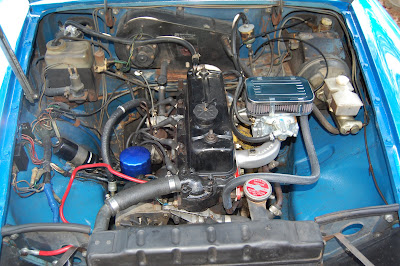I lowered the B on Saturday. Its a straightforward job really. The lowering kit contains two springs for the front, two spacers and four U bolts for the back. It cost $159 from Brittek. Here is a picture of the kit in an earlier post.
http://1977mgb.blogspot.com/2007/10/some-stuff-in-mail.html Note that the picture includes some rebound straps and a couple of sway bar bushings that I added to my order.
Starting at the back.
1. Loosen the wheel nuts.
2. Jack up the car under the rear differential and put axle stands under the front bracket that holds the leaf springs. Remove the wheels.
3. Lower the jack under the differential to take some of the tension out the springs.
4. Undo the U bolts. When you remove the nuts spring will drop down a bit.
5. Optional: Undo the nut to the suspension arm. This will allow the bottom plate to be removed.
6. If you are this far, you might as well remove the rear springs and swap them from left to right, that way if they drivers side sags a bit, you'll reduce the sag.
7. Replace the U bolts with the new ones.
8. Reassemble with the spacer block immediately above the spring, but below the upper rubber pad. Tighten the bolts to about 26lbs torque. Don't over tighten them the bolts can break.
9. Add new shorter rebound straps.
You should end up with something like this (note the shorter rebound straps).

Moving to the front (put the back down with the wheels on!)
1. Loosen wheel nuts.
2. Jack up the car and put the axle stands under the cross member.
3. Put a jack under the spring spring pan and jack it up to take the tension of the spring. Don't go too high or you'll tip the car off the jack stands.
4. Loosen the 3 bolts that hold the spring pan that sits at the bottom of the spring. Also remove the nut for the sway bar end. Removing the bolts is a bit tricky if you don't have the jack perfectly positioned. But I just tapped them out using a punch and a hammer. When the last one goes the spring will snap down a bit.
5. Lower the jack and remove the spring.
6. Reassemble and it should look like this:

Rebound Buffers.
You have to modify the rebound buffers at the rear and front because the existing ones are not going to allow enough travel vertically. You'll keep bottoming out as you fly over speed bumps.
On the rear, I just hacksawed off an inch. On the front its more involved. On this picture the buffer is number 18. The spacer is 17.

Remove the buffer (18) and the spacer (17). Cut the spacer in half with a hacksaw and reassemble it so that it is at the top of 18 not the bottom. You have to cut it because it won't align with the holes in the top of the buffer unit. The buffer may also need to be bent a little to line up with the holes in 17.
This picture shows the spacer in the upper position. Its in the top left hand corner.




























































